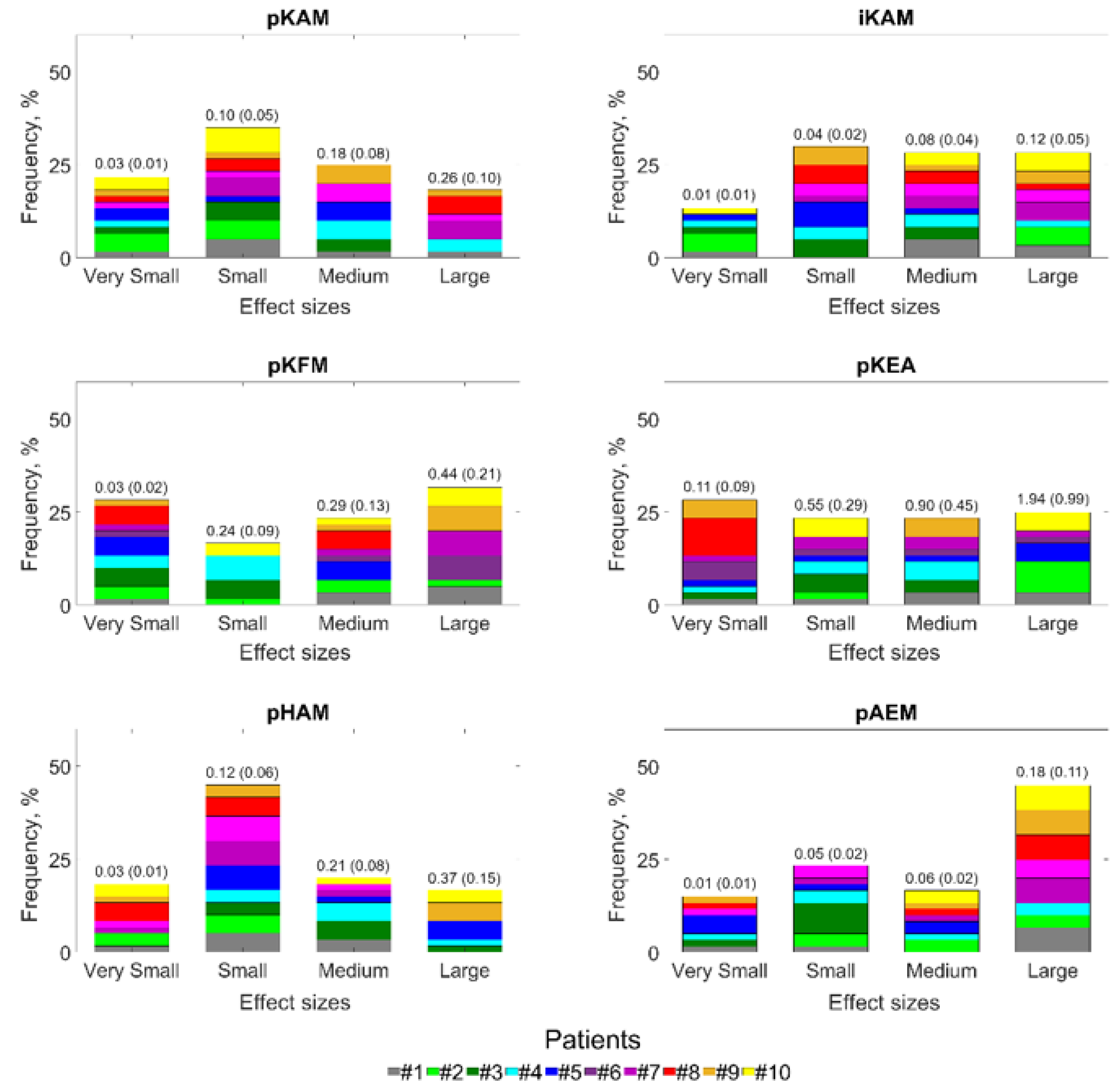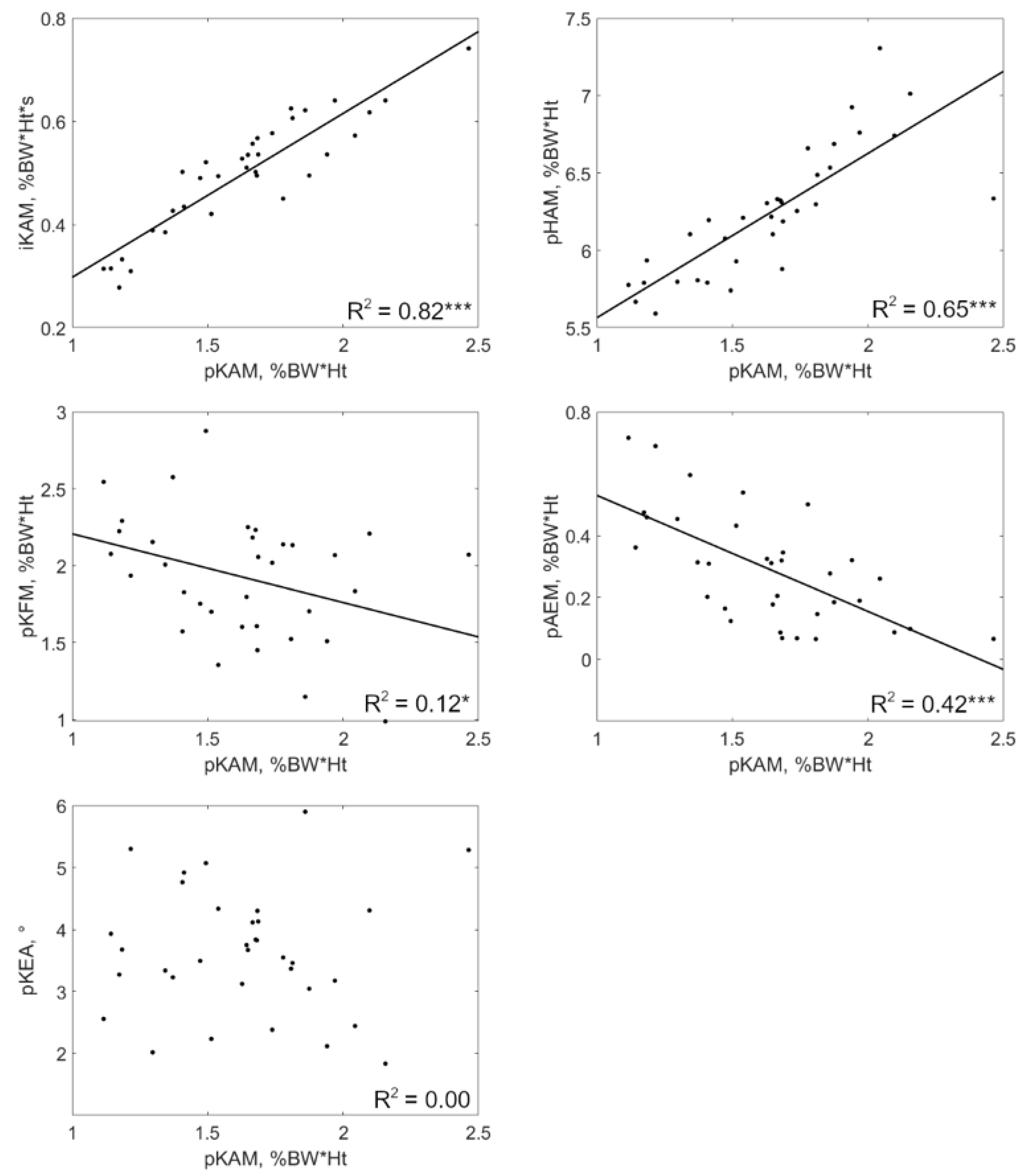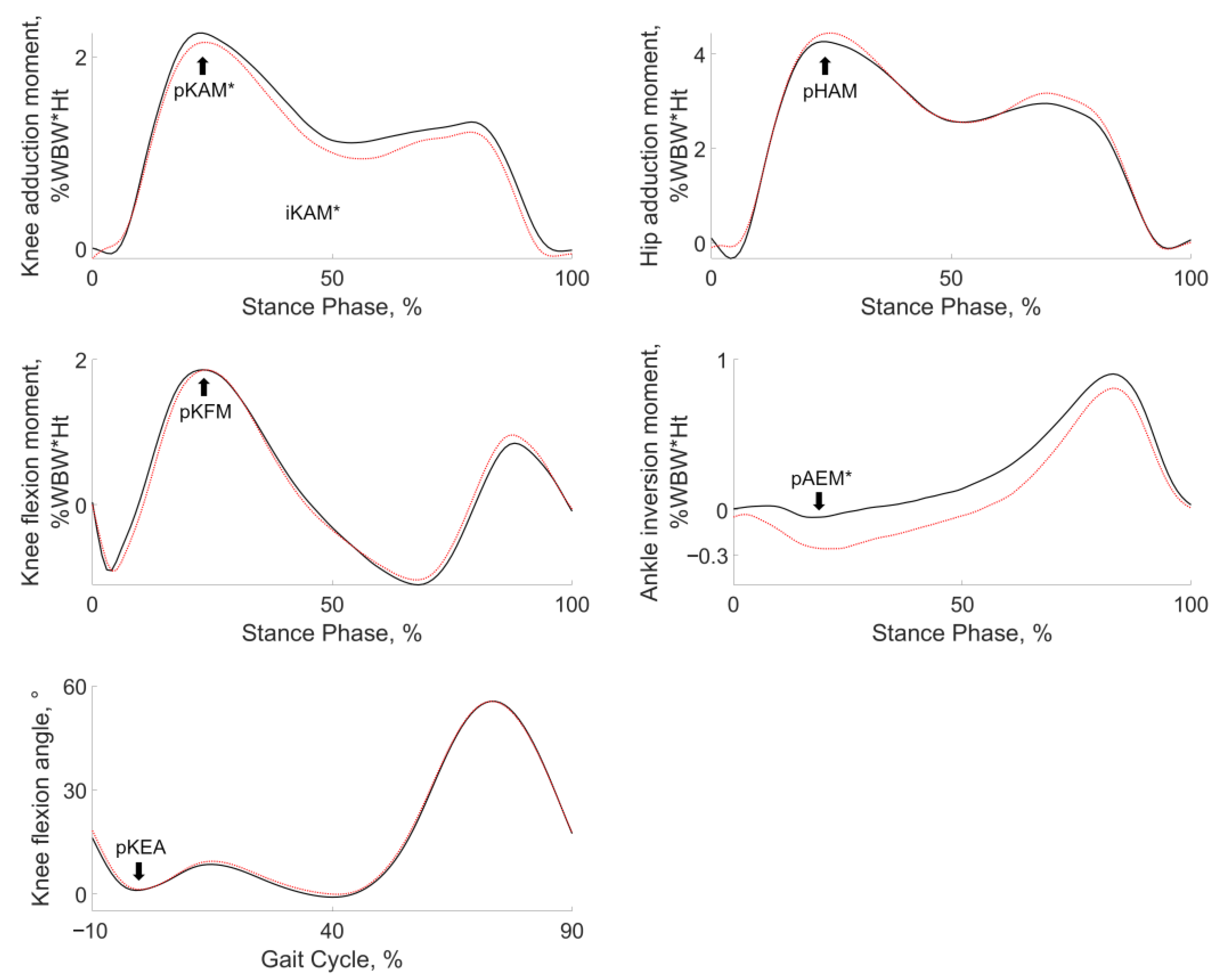Walking with Different Insoles Changes Lower-Limb Biomechanics Globally in Patients with Medial Knee Osteoarthritis
Abstract
1. Introduction
2. Materials and Methods
2.1. Patients
2.2. Gait Analysis
2.3. Statistical Analysis
3. Results
4. Discussion
5. Conclusions
Author Contributions
Funding
Institutional Review Board Statement
Informed Consent Statement
Data Availability Statement
Conflicts of Interest
References
- Cross, M.; Smith, E.; Hoy, D.; Nolte, S.; Ackerman, I.; Fransen, M.; Bridgett, L.; Williams, S.; Guillemin, F.; Hill, C.L. The global burden of hip and knee osteoarthritis: Estimates from the global burden of disease 2010 study. Ann. Rheum. Dis. 2014, 73, 1323–1330. [Google Scholar] [CrossRef] [PubMed]
- Andriacchi, T.P.; Favre, J. The nature of in vivo mechanical signals that influence cartilage health and progression to knee osteoarthritis. Curr. Rheumatol. Rep. 2014, 16, 463. [Google Scholar] [CrossRef] [PubMed]
- Favre, J.; Jolles, B.M. Gait analysis of patients with knee osteoarthritis highlights a pathological mechanical pathway and provides a basis for therapeutic interventions. EFORT Open Rev. 2016, 1, 368–374. [Google Scholar] [CrossRef] [PubMed]
- Ahlback, S. Osteoarthrosis of the knee. A radiographic investigation. Acta Radiol. 1968, 227, 7–72. [Google Scholar]
- Chehab, E.F.; Favre, J.; Erhart-Hledik, J.C.; Andriacchi, T.P. Baseline knee adduction and flexion moments during walking are both associated with 5 year cartilage changes in patients with medial knee osteoarthritis. Osteoarthr. Cartil. 2014, 22, 1833–1839. [Google Scholar] [CrossRef]
- Mündermann, A.; Dyrby, C.O.; Hurwitz, D.E.; Sharma, L.; Andriacchi, T.P. Potential strategies to reduce medial compartment loading in patients with knee osteoarthritis of varying severity: Reduced walking speed. Arthritis Rheum. Off. J. Am. Coll. Rheumatol. 2004, 50, 1172–1178. [Google Scholar] [CrossRef]
- Thorp, L.E.; Sumner, D.R.; Wimmer, M.A.; Block, J.A. Relationship between pain and medial knee joint loading in mild radiographic knee osteoarthritis. Arthritis Care Res. 2007, 57, 1254–1260. [Google Scholar] [CrossRef]
- Reeves, N.D.; Bowling, F.L. Conservative biomechanical strategies for knee osteoarthritis. Nat. Rev. Rheumatol. 2011, 7, 113–122. [Google Scholar] [CrossRef]
- Arnold, J.B.; Wong, D.X.; Jones, R.K.; Hill, C.L.; Thewlis, D. Lateral wedge insoles for reducing biomechanical risk factors for medial knee osteoarthritis progression: A systematic review and meta-analysis. Arthritis Care Res. 2016, 68, 936–951. [Google Scholar] [CrossRef]
- Radzimski, A.O.; Mündermann, A.; Sole, G. Effect of footwear on the external knee adduction moment—A systematic review. Knee 2012, 19, 163–175. [Google Scholar] [CrossRef]
- Shaw, K.E.; Charlton, J.M.; Perry, C.K.; de Vries, C.M.; Redekopp, M.J.; White, J.A.; Hunt, M.A. The effects of shoe-worn insoles on gait biomechanics in people with knee osteoarthritis: A systematic review and meta-analysis. Br. J. Sport. Med. 2018, 52, 238–253. [Google Scholar] [CrossRef]
- Parkes, M.J.; Maricar, N.; Lunt, M.; LaValley, M.P.; Jones, R.K.; Segal, N.A.; Takahashi-Narita, K.; Felson, D.T. Lateral wedge insoles as a conservative treatment for pain in patients with medial knee osteoarthritis: A meta-analysis. Jama 2013, 310, 722–730. [Google Scholar] [CrossRef]
- Zhang, J.; Wang, Q.; Zhang, C. Ineffectiveness of lateral-wedge insoles on the improvement of pain and function for medial knee osteoarthritis: A meta-analysis of controlled randomized trials. Arch. Orthop. Trauma Surg. 2018, 138, 1453–1462. [Google Scholar] [CrossRef]
- Bennell, K.L.; Bowles, K.-A.; Wang, Y.; Cicuttini, F.; Davies-Tuck, M.; Hinman, R.S. Higher dynamic medial knee load predicts greater cartilage loss over 12 months in medial knee osteoarthritis. Ann. Rheum. Dis. 2011, 70, 1770–1774. [Google Scholar] [CrossRef] [PubMed]
- Favre, J.; Erhart-Hledik, J.C.; Chehab, E.F.; Andriacchi, T.P. Baseline ambulatory knee kinematics are associated with changes in cartilage thickness in osteoarthritic patients over 5 years. J. Biomech. 2016, 49, 1859–1864. [Google Scholar] [CrossRef]
- Hajizadeh, M.; Desmyttere, G.; Carmona, J.-P.; Bleau, J.; Begon, M. Can foot orthoses impose different gait features based on geometrical design in healthy subjects? A systematic review and meta-analysis. Foot 2020, 42, 101646. [Google Scholar] [CrossRef]
- Hinman, R.S.; Bowles, K.A.; Metcalf, B.B.; Wrigley, T.V.; Bennell, K.L. Lateral wedge insoles for medial knee osteoarthritis: Effects on lower limb frontal plane biomechanics. Clin. Biomech. 2012, 27, 27–33. [Google Scholar] [CrossRef]
- Jones, R.K.; Chapman, G.J.; Parkes, M.J.; Forsythe, L.; Felson, D.T. The effect of different types of insoles or shoe modifications on medial loading of the knee in persons with medial knee osteoarthritis: A randomised trial. J. Orthop. Res. 2015, 33, 1646–1654. [Google Scholar] [CrossRef] [PubMed]
- Jones, R.K.; Chapman, G.J.; Forsythe, L.; Parkes, M.J.; Felson, D.T. The relationship between reductions in knee loading and immediate pain response whilst wearing lateral wedged insoles in knee osteoarthritis. J. Orthop. Res. 2014, 32, 1147–1154. [Google Scholar] [CrossRef] [PubMed]
- Manal, K.; Gardinier, E.; Buchanan, T.S.; Snyder-Mackler, L. A more informed evaluation of medial compartment loading: The combined use of the knee adduction and flexor moments. Osteoarthr. Cartil. 2015, 23, 1107–1111. [Google Scholar] [CrossRef] [PubMed]
- Walter, J.P.; D’Lima, D.D.; Colwell Jr, C.W.; Fregly, B.J. Decreased knee adduction moment does not guarantee decreased medial contact force during gait. J. Orthop. Res. 2010, 28, 1348–1354. [Google Scholar] [CrossRef]
- Simic, M.; Hinman, R.S.; Wrigley, T.V.; Bennell, K.L.; Hunt, M.A. Gait modification strategies for altering medial knee joint load: A systematic review. Arthritis Care Res. 2011, 63, 405–426. [Google Scholar] [CrossRef]
- Bowd, J.; Biggs, P.; Holt, C.; Whatling, G. Does Gait retraining have the potential to reduce medial compartmental loading in individuals with knee osteoarthritis while not adversely affecting the other lower limb joints? A systematic review. Arch. Rehabil. Res. Clin. Transl. 2019, 1, 100022. [Google Scholar] [CrossRef] [PubMed]
- Chapman, G.J.; Parkes, M.J.; Forsythe, L.; Felson, D.; Jones, R. Ankle motion influences the external knee adduction moment and may predict who will respond to lateral wedge insoles?: An ancillary analysis from the SILK trial. Osteoarthr. Cartil. 2015, 23, 1316–1322. [Google Scholar] [CrossRef] [PubMed]
- Kellgren, J.H.; Lawrence, J. Radiological assessment of osteo-arthrosis. Ann. Rheum. Dis. 1957, 16, 494. [Google Scholar] [CrossRef] [PubMed]
- Chehab, E.; Andriacchi, T.; Favre, J. Speed, age, sex, and body mass index provide a rigorous basis for comparing the kinematic and kinetic profiles of the lower extremity during walking. J. Biomech. 2017, 58, 11–20. [Google Scholar] [CrossRef]
- Andriacchi, T.P.; Alexander, E.J.; Toney, M.; Dyrby, C.; Sum, J.a. A point cluster method for in vivo motion analysis: Applied to a study of knee kinematics. J. Biomech. Eng. 1998, 120, 743–749. [Google Scholar] [CrossRef]
- Favre, J.; Aissaoui, R.; Jolles, B.M.; de Guise, J.A.; Aminian, K. Functional calibration procedure for 3D knee joint angle description using inertial sensors. J. Biomech. 2009, 42, 2330–2335. [Google Scholar] [CrossRef] [PubMed]
- Grood, E.S.; Suntay, W.J. A joint coordinate system for the clinical description of three-dimensional motions: Application to the knee. J. Biomech. Eng. 1983, 105, 136–144. [Google Scholar] [CrossRef]
- Zabala, M.E.; Favre, J.; Scanlan, S.F.; Donahue, J.; Andriacchi, T.P. Three-dimensional knee moments of ACL reconstructed and control subjects during gait, stair ascent, and stair descent. J. Biomech. 2013, 46, 515–520. [Google Scholar] [CrossRef] [PubMed]
- Cohen, J. Statistical Power Analysis for the Behavioral Sciences; Routledge: New York, NY, USA, 2013. [Google Scholar]
- Favre, J.; Erhart-Hledik, J.C.; Chehab, E.F.; Andriacchi, T.P. General scheme to reduce the knee adduction moment by modifying a combination of gait variables. J. Orthop. Res. 2016, 34, 1547–1556. [Google Scholar] [CrossRef] [PubMed]
- Ulrich, B.; Cosendey, K.; Jolles, B.M.; Favre, J. Decreasing the ambulatory knee adduction moment without increasing the knee flexion moment individually through modifications in footprint parameters: A feasibility study for a dual kinetic change in healthy subjects. J. Biomech. 2020, 111, 110004. [Google Scholar] [CrossRef] [PubMed]
- Muro-De-La-Herran, A.; Garcia-Zapirain, B.; Mendez-Zorrilla, A. Gait analysis methods: An overview of wearable and non-wearable systems, highlighting clinical applications. Sensors 2014, 14, 3362–3394. [Google Scholar] [CrossRef]
- Zafar, A.Q.; Zamani, R.; Akrami, M. The effectiveness of foot orthoses in the treatment of medial knee osteoarthritis: A systematic review. Gait Posture 2020, 76, 238–251. [Google Scholar] [CrossRef] [PubMed]
- Erhart-Hledik, J.; Chu, C.; Asay, J.; Favre, J.; Andriacchi, T. Longitudinal changes in the total knee joint moment after anterior cruciate ligament reconstruction correlate with cartilage thickness changes. J. Orthop. Res. 2019, 37, 1546–1554. [Google Scholar] [CrossRef]
- Kwon, S.B.; Ku, Y.; Han, H.-S.; Lee, M.C.; Kim, H.C.; Ro, D.H. A machine learning-based diagnostic model associated with knee osteoarthritis severity. Sci. Rep. 2020, 10, 15743. [Google Scholar] [CrossRef]
- Leporace, G.; Gonzalez, F.; Metsavaht, L.; Motta, M.; Carpes, F.P.; Chahla, J.; Luzo, M. Are there different gait profiles in patients with advanced knee osteoarthritis? A machine learning approach. Clin. Biomech. 2021, 88, 105447. [Google Scholar] [CrossRef]
- Felson, D.T.; Parkes, M.; Carter, S.; Liu, A.; Callaghan, M.J.; Hodgson, R.; Bowes, M.; Jones, R.K. The efficacy of a lateral wedge insole for painful medial knee osteoarthritis after prescreening: A randomized clinical trial. Arthritis Rheumatol. 2019, 71, 908–915. [Google Scholar] [CrossRef]
- Shull, P.B.; Lurie, K.L.; Cutkosky, M.R.; Besier, T.F. Training multi-parameter gaits to reduce the knee adduction moment with data-driven models and haptic feedback. J. Biomech. 2011, 44, 1605–1609. [Google Scholar] [CrossRef]
- Tezcan, M.E.; Goker, B.; Lidtke, R.; Block, J.A. Long-term effects of lateral wedge orthotics on hip and ankle joint space widths. Gait Posture 2017, 51, 36–40. [Google Scholar] [CrossRef]
- Bartsch, L.P.; Schwarze, M.; Block, J.; Alimusaj, M.; Hadzic, A.; Renkawitz, T.; Wolf, S.I. Hindfoot flexibility influences the biomechanical effects of laterally wedged insoles and ankle-foot orthoses in medial knee osteoarthritis. Arch. Phys. Med. Rehabil. 2022, 103, 1699–1706. [Google Scholar] [CrossRef] [PubMed]
- Sawada, T.; Tokuda, K.; Tanimoto, K.; Iwamoto, Y.; Ogata, Y.; Anan, M.; Takahashi, M.; Kito, N.; Shinkoda, K. Foot alignments influence the effect of knee adduction moment with lateral wedge insoles during gait. Gait Posture 2016, 49, 451–456. [Google Scholar] [CrossRef] [PubMed]
- Ulrich, B.; Hoffmann, L.; Jolles, B.M.; Favre, J. Changes in ambulatory knee adduction moment with lateral wedge insoles differ with respect to the natural foot progression angle. J. Biomech. 2020, 103, 109655. [Google Scholar] [CrossRef] [PubMed]



| Characteristics | Values | |
|---|---|---|
| Participants | Gender, number of males/females | 9/1 |
| Age, years old | 57.20 ± 8.32 | |
| Height, m | 1.73 ± 0.94 | |
| Weight, kg | 88.90 ± 12.58 | |
| Self-selected normal walking speed, m/s | 1.31 ± 0.12 | |
| Study knees | Side, number of left/right knees | 5/5 |
| Kellgren–Lawrence grades, range: 0–4 | 2.14 ± 0.90 | |
| Visual Analogue Scale (VAS), range: 0–10 | ||
| Pain | 3.30 ± 2.31 | |
| Symptoms | 3.20 ± 2.20 | |
| Knee Injury and Osteoarthritis Outcome Score (KOOS), range 0–100 | ||
| General | 60.60 ± 15.53 | |
| Pain | 67.50 ± 17.25 | |
| Symptoms | 69.60 ± 13.71 | |
| Function, daily living | 78.30 ± 15.07 | |
| Function, sports and recreational activities | 47.50 ± 23.24 | |
| Quality of life | 40.60 ± 19.97 | |
| Gait Variable | Patient | R2 | β a | Absolute Changes with 10% pKAM Decrease b | Relative Changes with 10% pKAM Decrease c |
|---|---|---|---|---|---|
| iKAM | #1 | 0.34 *** | 0.24 | −0.08 | −9.78 |
| #2 | 0.50 *** | 0.21 | −0.05 | −13.47 | |
| #3 | 0.59 *** | 0.35 | −0.08 | −9.87 | |
| #4 | 0.42 *** | 0.55 | −0.25 | −11.41 | |
| #5 | 0.55 *** | 0.24 | −0.05 | −7.88 | |
| #6 | 0.41 *** | 0.22 | −0.03 | −9.58 | |
| #7 | 0.31 *** | 0.20 | −0.07 | −5.07 | |
| #8 | 0.73 *** | 0.45 | −0.10 | −15.61 | |
| #9 | 0.82 *** | 0.32 | −0.05 | −10.39 | |
| #10 | 0.20 * | 0.19 | −0.06 | −4.93 | |
| pKFM | #1 | 0.09 | 0.52 | n/a | n/a |
| #2 | 0.60 *** | 1.23 | −0.31 | −18.15 | |
| #3 | 0.38 *** | 1.73 | −0.42 | 108.12 | |
| #4 | 0.02 | −0.38 | n/a | n/a | |
| #5 | 0.25 ** | 0.66 | −0.14 | −8.38 | |
| #6 | 0.11 * | −0.61 | 0.07 | 2.50 | |
| #7 | 0.03 | −0.33 | n/a | n/a | |
| #8 | 0.00 | −0.01 | n/a | n/a | |
| #9 | 0.12 * | −0.45 | 0.07 | 3.79 | |
| #10 | 0.00 | 0.02 | n/a | n/a | |
| pKEA | #1 | 0.04 | −0.35 | n/a | n/a |
| #2 | 0.02 | −0.57 | n/a | n/a | |
| #3 | 0.37 *** | 7.06 | −1.71 | 34.02 | |
| #4 | 0.00 | 0.22 | n/a | n/a | |
| #5 | 0.02 | 1.73 | n/a | n/a | |
| #6 | 0.01 | 0.60 | n/a | n/a | |
| #7 | 0.00 | −0.07 | n/a | n/a | |
| #8 | 0.00 | 0.09 | n/a | n/a | |
| #9 | 0.00 | −0.04 | n/a | n/a | |
| #10 | 0.01 | 0.55 | n/a | n/a | |
| pHAM | #1 | 0.87 *** | 0.98 | −0.31 | −6.02 |
| #2 | 0.84 *** | 1.40 | −0.35 | −7.02 | |
| #3 | 0.49 *** | 0.74 | −0.18 | −6.43 | |
| #4 | 0.42 *** | 0.77 | −0.35 | −5.38 | |
| #5 | 0.37 *** | 1.12 | −0.25 | −6.15 | |
| #6 | 0.33 *** | 1.01 | −0.11 | −2.15 | |
| #7 | 0.74 *** | 1.12 | −0.39 | −9.57 | |
| #8 | 0.61 *** | 0.99 | −0.22 | −4.12 | |
| #9 | 0.65 *** | 1.06 | −0.17 | −2.77 | |
| #10 | 0.17 * | 0.34 | −0.10 | −1.99 | |
| pAEM | #1 | 0.09 | 0.23 | n/a | n/a |
| #2 | 0.00 | 0.02 | n/a | n/a | |
| #3 | 0.09 | 0.15 | n/a | n/a | |
| #4 | 0.30 *** | 0.15 | −0.07 | 74.22 | |
| #5 | 0.45 *** | 0.22 | −0.05 | 25.84 | |
| #6 | 0.22 ** | 0.30 | −0.03 | 13.86 | |
| #7 | 0.32 *** | 0.29 | −0.10 | 95.28 | |
| #8 | 0.36 *** | 0.23 | −0.05 | 19.11 | |
| #9 | 0.42 *** | 0.37 | −0.06 | 20.92 | |
| #10 | 0.01 | 0.05 | n/a | n/a |
| Gait Variable | Values with the Arch Support Insole | Changes with the Addition of a Lateral Wedge | Inter-Patient Correlations between Changes in pKAM and Changes in the Other Gait Variables | |||
|---|---|---|---|---|---|---|
| Mean | SD | Mean | SD | ES | R2 | |
| pKAM | 2.62 | 0.94 | −0.09 | 0.13 | −0.70 * | n/a |
| iKAM | 0.89 | 0.57 | −0.06 | 0.08 | −0.75 * | 0.62 ** |
| pKFM | 2.24 | 1.49 | −0.02 | 0.37 | −0.07 | 0.00 |
| pKEA | 0.80 | 4.75 | 0.49 | 1.31 | 0.37 | 0.05 |
| pHAM | 4.88 | 1.17 | 0.10 | 0.20 | 0.51 | 0.25 |
| pAEM | −0.23 | 0.20 | −0.13 | 0.07 | −1.76 *** | 0.14 |
Disclaimer/Publisher’s Note: The statements, opinions and data contained in all publications are solely those of the individual author(s) and contributor(s) and not of MDPI and/or the editor(s). MDPI and/or the editor(s) disclaim responsibility for any injury to people or property resulting from any ideas, methods, instructions or products referred to in the content. |
© 2023 by the authors. Licensee MDPI, Basel, Switzerland. This article is an open access article distributed under the terms and conditions of the Creative Commons Attribution (CC BY) license (https://creativecommons.org/licenses/by/4.0/).
Share and Cite
Jaques, G.; Ulrich, B.; Hoffmann, L.; Jolles, B.M.; Favre, J. Walking with Different Insoles Changes Lower-Limb Biomechanics Globally in Patients with Medial Knee Osteoarthritis. J. Clin. Med. 2023, 12, 2016. https://doi.org/10.3390/jcm12052016
Jaques G, Ulrich B, Hoffmann L, Jolles BM, Favre J. Walking with Different Insoles Changes Lower-Limb Biomechanics Globally in Patients with Medial Knee Osteoarthritis. Journal of Clinical Medicine. 2023; 12(5):2016. https://doi.org/10.3390/jcm12052016
Chicago/Turabian StyleJaques, Guillaume, Baptiste Ulrich, Laurent Hoffmann, Brigitte M. Jolles, and Julien Favre. 2023. "Walking with Different Insoles Changes Lower-Limb Biomechanics Globally in Patients with Medial Knee Osteoarthritis" Journal of Clinical Medicine 12, no. 5: 2016. https://doi.org/10.3390/jcm12052016
APA StyleJaques, G., Ulrich, B., Hoffmann, L., Jolles, B. M., & Favre, J. (2023). Walking with Different Insoles Changes Lower-Limb Biomechanics Globally in Patients with Medial Knee Osteoarthritis. Journal of Clinical Medicine, 12(5), 2016. https://doi.org/10.3390/jcm12052016






